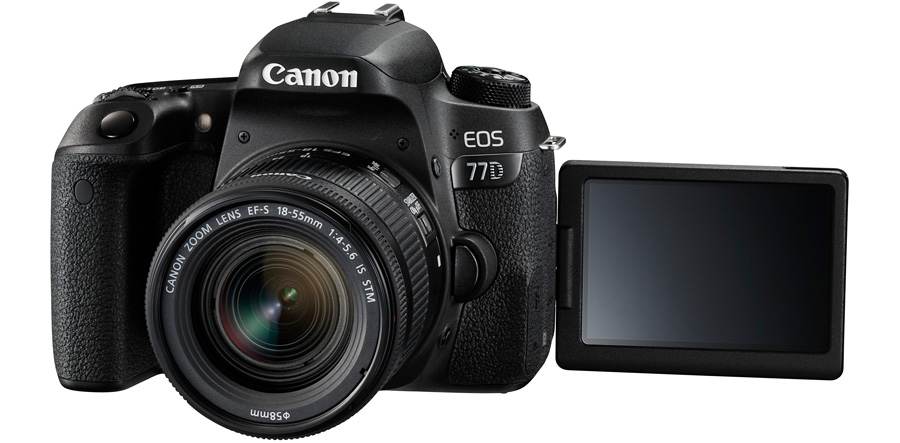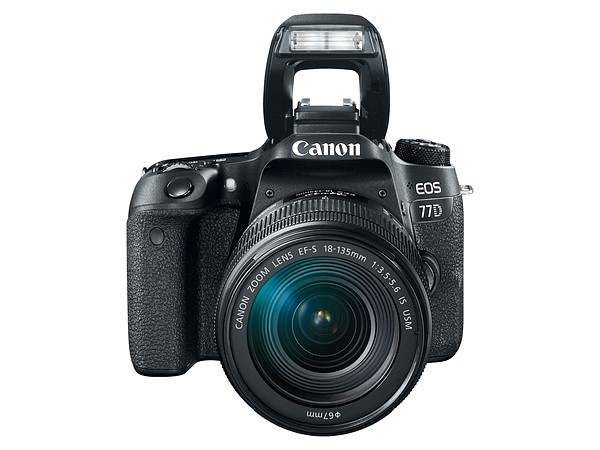
In February, Canon announced the EOS Rebel T7i (800D) and EOS 77D, adding two new choices to the company's already confusing lineup. In this article we'll break down what separates the T7i, 77D and the existing EOS 80D – and which is the best one for your needs.
Spec comparison
Rebel T7i/800D
EOS 77D
EOS 80D
MSRP (body only)
$749
$899
$1199
Sensor
24. 2MP APS-C CMOS
Processor
Digic 7
Digic 6
ISO range
ISO 100-25600
(expands to 51200)
ISO 100-12800
(expands to 25600)
AF system
Dual Pixel + 45-pt all-cross-type
Shutter speed
30 - 1/4000 sec
30 - 1/8000 sec
X-sync
1/200 sec
1/250 sec
LCD size/type
3" fully-articulating (1. 04M-dot)
Viewfinder mag/coverage
0. 82x / 95%
0. 95x / 100%
('Intelligent')
Control dials
One
Two
Max Continuous
6 fps
7 fps
Video
1920 x 1080 @ 60p/30p/24p
Headphone jack
No
Yes
Bluetooth
Yes
No
Battery life (CIPA)
600 shots
960 shots
Battery grip
No
Optional
Weather-sealing
No
Yes
Dimensions
131 x 100 x 76mm
131 x 100 x 76mm
139 x 105 x 79mm
Weight (CIPA)
532 g
540 g
730 g
In most respects, the 80D is the better of the three cameras, which is what you'd expect given its price premium. Let's break it down into various areas for a closer look.
Body & Design
What really sets these three models apart are style and build quality. The EOS Rebel T7i is very much a Rebel. It's compact, plastic and has a single control dial and small-ish optical viewfinder. The T7i, along with the other two cameras in this comparison, has a 3" fully articulating touchscreen LCD.
The Rebel T7i's top-plate controls are all located on the right side.
The EOS 77D adds an LCD info display in the place of the mode dial, which moves to the left.
The optical viewfinder, LCD and most of the controls are the same on the T7i as they are on the 77D.
The 77D adds a second control dial around the directional controller (with a lock switch) as well as an AF-On button for fans of back-button focus.
As you'd expect, the 80D is bigger and better in terms of build quality. The body is weather-sealed and the shutter is rated to 100,000 cycles (Canon doesn't say how long the Rebel and 77D will last, but it's probably safe to say 'not as long'. ) Its pentaprism 'Intelligent Viewfinder' has 100% coverage and the ability to overlay all kind of information on top of the scene, such as focus point layout, composition grids and an electronic level. The grip is larger and, unlike the other two models, a battery grip is an optional extra. The 80D also offers a headphone jack, in addition to the mic jack found on the other two models.
The controls on the 77D are quite similar to those on the 80D.
The 80D has a larger viewfinder and no labels on its directional controller. It lacks the Wi-Fi button found on the 77D.
Again, the 77D closely resembles its big brother.
The 80D has additional buttons, though, for AF, drive and metering.
The Guts
The Rebel T7i, EOS 77D and EOS 80D share the same 24MP APS-C CMOS sensor. However, the Rebel and 77D have Canon's latest Digic 7 processor, compared to the Digic 6 on the 80D. Canon claims that the Digic 7 provides a full-stop improvement in JPEG high ISO noise levels compared to Digic 6, though comparing the Digic 7-powered EOS M5 against the 80D seems to contradict that. In addition, the native ISO range tops out at 25600 on Digic 7 vs 12800 on Digic 6. All three cameras can further expand their maximum ISO by a full stop.
Canon says that the Digic 7 also improves subject-tracking performance, and when we reviewed the EOS M5 mirrorless camera, we found it to be a step above the EOS 80D. It's probably a safe assumption that the Rebel T7i and EOS 77D will perform as well as the M5 when live view shooting.
Digics aside, all three cameras use the same Dual Pixel CMOS AF system, which we've found to be effective for both stills and video. They also share a 45-point, all-cross-type phase-detect system for shooting through the viewfinder as well as a 7560-pixel RGB+IR metering sensor that uses 'Color Tracking' to detect skin color and assist in focusing.
When shooting through the viewfinder on all three cameras you'll get 45 all-cross-type points, with the center-point being dual-cross-type.
Dual Pixel AF has phase-detect pixels built into the CMOS sensor, which allows for fast AF in live view and video. The phase-detect area covers 80% of the frame, as illustrated above.
Features
This is the area in which the three cameras start to diverge, though not dramatically. Let's start at the bottom with the Rebel T7i/800D.
The T7i offers Full HD video capture at 60p, 30p and 24p, as well as the PAL equivalents at bit rates of up to 60Mbps. You get manual exposure control and Auto ISO while capturing video, though it's not clear if the T7i will let you adjust exposure compensation in those situations (signs point to 'yes'). Manual audio level controls are available, plus a wind filter.
You get to take advantage of Dual Pixel AF's solid subject tracking performance and easy rack-focusing courtesy of the touchscreen display. There's also a time-lapse movie mode and an HDR movie mode (shudder). Something that the Digic 7 allows for is 5-axis digital image stabilization, which is a feature the 80D's Digic 6 does not support.
In terms of continuous shooting, the T7i can take up to 27 Raw, 23 Raw+JPEG or an unlimited number of JPEGs at 6 fps, assuming that you're using a high-speed UHS-I card. Battery life sits at 600 shots per charge (CIPA standard).
And then there's Wi-Fi, which is Canon's most advanced system yet. You get the usual Wi-Fi connectivity using the Canon Connect app, as well as NFC for quick pairing with Android phones. What's new is Bluetooth support, which not only makes pairing easy, but also maintains a constant connection so you can quickly turn your phone into a remote. When using the app with Bluetooth there's a shutter release button for shooting, plus a four-way controller for playback. If you want full-on remote control with live view, the app will automatically switch over to Wi-Fi.
Canon's new BR-E1 Bluetooth remote is compatible with the Rebel T7i/800D and the EOS 77D. Notice the W/T buttons, which can be used with the available PZ-E1 power zoom adapter (that only works with the EF-S 18-135mm PZ at this time).
Something new the T7i/800D brings to the table is Feature Assistant, which is very similar to the Guide feature on the Nikon D3000-series. When you rotate the mode dial, the LCD displays visual representations of what each mode does. Once you've selected a mode, you'll get a slider that illustrates the effect of aperture or shutter speed adjustment. It's pretty well-done for those who learn toward the beginner end of the spectrum. This feature is also available on the EOS 77D, though it's hidden by default.
So what features do you gain by stepping up to the EOS 77D, aside from the physical ones? Not a whole lot. You gain interval and bulb timers and a few more custom controls (due to the extra physical buttons). Everything else, including burst rate and battery life, is identical.
Moving up to the 80D mostly provides better performance and even more custom controls. Performance-wise, the max shutter speed rises to 1/8000 sec, the x-sync speed to 1/250 sec, and the burst rate to 7 fps. Battery life is rated at 960 shots per charge, and that's without the optional grip.
Feature-wise you gain a lot more control over autofocus settings, and an AF micro-adjustment tool is also available. What are you missing out on by having a slightly older camera? Really it's just Bluetooth and the 5-axis digital IS in movie mode (we can't imagine your average 80D buyer using the Feature Assistant very often).
So which is best for you?
The difficult decision isn't so much between the 77D and the 80D - the differences are pretty clear-cut. If you need something with much superior build quality, faster burst rates and more controls over autofocus, then it's your choice. While the 80D's live view subject tracking abilities may fall below that of the 77D (and T7i), image quality should be similar, despite Canon's claims to the contrary.
The Rebel T7i / EOS 800D showing off its new UI.
The choice between the Rebel T7i/800D vs the 77D is where it's a bit more challenging. Obviously, budget will be one thing any buyer will consider. If you're pinching pennies then you're probably going to choose the Rebel, whose innards are considering better than the T6i which it replaces. If you're willing to spend about $150 more, then we think that the EOS 77D is the better choice. It's not any larger, the extra control dial saves a lot of hassle and the LCD info display is a nice touch.
If you're trying to make this exact decision right now, or just want to propose alternatives, then head down to the comment section below. Let us know if we missed anything in this comparison, too!
. dpreview.com2017-2-23 18:00









